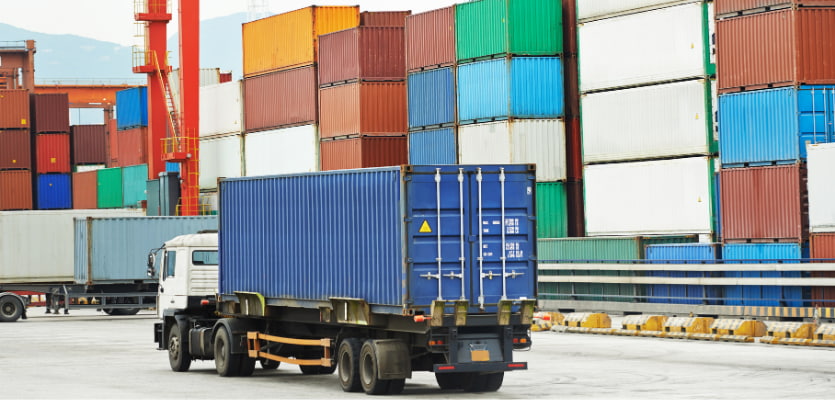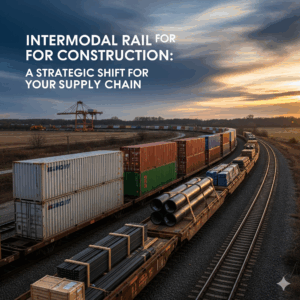Comprehensive Guide to Intermodal Services for Successful Shipping in 2025
Editor’s note: This post was initially published on January 3rd, 2022 and has since been revised for comprehensiveness
If you’re searching for smarter, more efficient logistics strategies this year, look no further than intermodal services. In today’s competitive shipping environment, intermodal services offer shippers the ability to combine multiple modes of transport – typically rail, truck, and sea – into one streamlined journey. Whether you’re a small business owner looking to expand across Canada or a logistics manager trying to reduce operational expenses, intermodal services in 2025 are more advanced and accessible than ever.
With increased demand for green transportation solutions and supply chain resilience, companies are turning to intermodal services for consistent, reliable freight movement. By utilizing standardized containers, freight moves seamlessly between different modes without handling the contents. This not only protects the cargo but also slashes transit costs and reduces carbon emissions.
So, what makes intermodal services so attractive today? The answer lies in cost-effectiveness, scalability, and sustainability. With rail being more fuel-efficient than trucks, and with ocean freight covering large distances affordably, businesses can now optimize routes while reducing environmental impact. In 2025, new digital tools also make intermodal services easier to track and manage, giving shippers greater visibility into every leg of the journey. Whether you’re shipping across provinces or managing a cross-border operation, intermodal services provide unparalleled flexibility. From reducing last-mile delays to expanding your delivery network, these services cater to a wide variety of needs across industries. As fuel prices and congestion continue to climb, intermodal services stand out as a forward-thinking solution for companies seeking better logistics.

What Is Intermodal Shipping?
Intermodal shipping is a highly efficient freight transportation method that uses multiple modes of transport – such as trucks, trains, and cargo ships – without ever having to unpack the cargo when switching between carriers. This is made possible through the use of standardized intermodal containers, which are designed to be seamlessly moved from one transport mode to another.
In the world of logistics, intermodal shipping offers a game-changing advantage: it combines the flexibility of trucking, the cost-efficiency of rail, and the global reach of ocean freight into a single, integrated solution. This approach minimizes manual cargo handling, reduces the risk of damage or theft, and streamlines transit from origin to destination.
The core concept of intermodal shipping revolves around containerization. Products are loaded into standardized containers – often 20 or 40 feet long – and remain sealed throughout the journey. Whether you’re moving goods across provinces or continents, these containers allow for quick transitions between modes at intermodal terminals without unpacking or repacking the shipment.
In countries like Canada and the U.S., intermodal shipping plays a vital role in supporting both domestic and international trade. For example, goods may begin their journey on a truck, be transferred onto a train for long-haul travel across the country, and finally arrive at a port for ocean freight—without ever being removed from the container.
Key benefits of intermodal shipping include:
- Lower transportation costs through the use of rail for long-distance hauling
- Reduced carbon emissions compared to trucking alone
- Enhanced security due to minimal cargo handling
- Improved efficiency through optimized routing and container utilization
Whether you’re a manufacturer shipping to distribution centers, a retailer restocking across regions, or an exporter sending freight overseas, intermodal shipping provides a scalable and resilient logistics solution. By leveraging multiple transportation modes in a single, uninterrupted shipment, businesses can cut costs, speed up delivery, and improve supply chain performance.
Understanding what intermodal shipping is – and how it fits into your logistics strategy – can make all the difference in today’s competitive freight environment.
Types Of Intermodal Services Explained
The world of intermodal shipping offers various service options to meet diverse needs. Here’s a breakdown of some key terms:
- Door-to-Door Intermodal Services (D2D)
This service provides comprehensive pick-up and delivery, taking your product directly from the vendor’s doorstep to the recipient’s. While D2D services typically operate between designated locations, they offer a seamless end-to-end experience.
Imagine a product shipped by truck or rail to a central depot. There, it’s consolidated with other shipments headed for the same region before being loaded onto a ship. The vessel might visit other ports to collect additional cargo destined for the final inland destination.
To ensure smooth delivery across multiple modes, shippers and carriers often establish a “through bill of lading.” This document acts as a contract, outlining the entire shipping process and the responsibilities of each party involved.
- Terminal Direct Intermodal Service
This service focuses on point-to-point or loop routes using standardized containers for shipping. The cargo is loaded at the shipper’s premises, transported to an intermodal terminal, and then delivered by rail or truck to its final destination.
The key benefit here is the elimination of intermediate cargo handling by the shipper. This translates to reduced costs for both the railroad and the shipper. Additionally, this service offers flexibility to switch to trucks in case of train schedule disruptions.
- Domestic Intermodal Service
This service refers to the movement of a container or trailer within a single country, utilizing different transportation modes and at least one connecting carrier.
The process typically begins with the shipper delivering the cargo to a designated location like a warehouse or rail yard. The carrier then reloads the cargo at another point (rail yard, port, airport, etc.) and delivers it to its final destination using a different mode of transportation.
- International Intermodal Service
This service caters to global cargo movement, similar to domestic service but on a larger scale. It involves multiple transportation modes, at least one connecting carrier, and spans international borders.
The process starts with the cargo being delivered to a local pick-up point. The carrier then reloads it at a rail yard, port, or airport for further transportation. Depending on the chosen route, this could involve ocean freight followed by final delivery via truck to the final destination.
How Does Intermodal Transportation Work
At the heart of intermodal transportation lies the intermodal container. These specially designed containers are engineered to seamlessly transfer between various modes of transport, including trucks, trains, ships, and even airplanes. This standardization allows for a streamlined and efficient logistics process, as outlined below:
- Starting
The journey begins with the cargo being securely loaded into a container. Often, trucks are employed for initial transport to a nearby terminal.
- Transfer
Upon arrival at the terminal, the container undergoes a smooth transfer to the designated mode of transport for the next leg of the journey. This could be a train, ship, or airplane, depending on the chosen route and distance.
- Transportation
The container, now securely fastened to its new carrier, embarks on its journey to the final destination. For long-distance hauls, trains or ships may offer the most efficient method of transport. Shorter distances, on the other hand, might be best served by trucks.
- Destination
Once the container reaches its final destination, it is unloaded from the chosen mode of transport. For the final delivery leg, trucks are often used to transport the container directly to its designated recipient.
This approach of utilizing standardized containers facilitates a more streamlined, efficient, and cost-effective logistics process. By leveraging the strengths of each transportation mode and minimizing cargo handling, intermodal transportation offers significant advantages for businesses and consumers alike.

What Can Be Shipped Using Intermodal Shipments?
Intermodal transportation offers remarkable versatility, allowing a wide range of goods for shipment. Here are some of the possible shipments allowed:
- Consumer Products
From electronics and clothing to household items, intermodal transportation efficiently delivers these everyday essentials.
- Industrial Supplies
Heavy machinery, raw materials, and construction equipment can all be transported seamlessly through this method.
- Vehicles
Cars and trucks are not excluded; intermodal transportation offers a secure and efficient way to move them across vast distances.
- Food and Beverages
Even perishable goods can benefit from the swift and reliable movement facilitated by intermodal transportation.
- Bulk Cargo
Large quantities of grains, coal, and minerals are frequently transported in specialized containers or rail cars designed for intermodal shipping.
But do be careful as intermodal transportation isn’t a one-size-fits-all solution. Certain items may have size, hazard, or regulatory restrictions. Partnering with a logistics expert ensures your cargo aligns with the most efficient and compliant shipping method.
Advantages and Disadvantages of Intermodal Services
Intermodal transportation offers a compelling option for freight movement. While its benefits are undeniable, it’s important to consider both the advantages and disadvantages before making a decision.
Advantages of Intermodal Shipping:
- Enhanced Efficiency
Intermodal transportation leverages the strengths of various modes, leading to potentially faster delivery times compared to traditional methods.
- Reduced Environmental Impact
By combining modes like trains and ships, intermodal transportation can contribute to lower noise pollution and traffic congestion.
- Increased Reliability
Fewer delays and disruptions are possible due to the flexibility of switching between transportation modes if necessary.
- Simplified Logistics
Intermodal shipping often streamlines planning and scheduling, thanks to consolidated departure schedules.
- Cost-Effectiveness
By eliminating the need for multiple container transfers, intermodal transportation can reduce costs associated with traditional shipping methods.
- Large-Scale Project Support
This method is well-suited for handling large-scale projects due to its ability to manage high volumes of cargo efficiently.
Disadvantages of Intermodal Shipping:
- Potential for Unreliable Service Providers
Working with multiple carriers for each leg of the journey increases the chance of encountering unreliable service. Researching and selecting reputable partners is crucial.
- Slower Speeds with Delays
While intermodal transport can be faster under ideal conditions, the possibility of delays due to issues with any carrier can significantly impact overall speed.
- Increased Complexity
Detailed planning and coordination are essential for seamless intermodal shipping. It’s not a last-minute solution and requires careful consideration of the entire journey.
- Higher Risk of Product Damage
The transfer of cargo between carriers can lead to increased handling and potentially more damage compared to single-carrier transport. Choosing experienced and careful companies for each leg can mitigate this risk.
By carefully weighing these advantages and disadvantages, businesses can determine if intermodal transportation aligns with their specific needs and priorities.
Should You Choose Intermodal Services
Intermodal transportation’s versatility extends to a wide range of businesses and organizations. Here’s where it truly excels in:
- Long-Distance Freight
For companies that ship goods across vast distances, intermodal transportation offers a compelling solution. It combines the efficiency and cost-effectiveness of various transportation modes, making it an ideal choice for long-haul journeys.
- Cost-Conscious Businesses
Intermodal transportation often translates to significant cost savings. The efficient utilization of multiple modes and standardized containers minimizes handling and reduces the risk of damage, leading to a more economical shipping experience.
- Sustainability-Oriented Organizations
Compared to traditional methods, intermodal transportation boasts a smaller environmental footprint. Organizations committed to sustainability goals can significantly reduce their carbon footprint by choosing this eco-friendly approach.
The decision to utilize intermodal transportation depends on your specific needs. When prioritizing speed and simplicity, traditional methods may be preferable. However, if efficiency, cost savings, and environmental impact are key considerations, intermodal shipping offers a compelling alternative. By carefully weighing the advantages and disadvantages, you can make an informed decision for your business.
Conclusion
If you’re not already leveraging intermodal services, now is the time to make the shift. In 2025, businesses face rising customer expectations, complex regulatory demands, and increasing fuel costs. Thankfully, intermodal services provide a resilient, scalable solution that allows shippers to navigate these challenges with confidence. Whether you’re shipping electronics, clothing, raw materials, or perishables, intermodal services offer a smart path forward.
The beauty of intermodal services lies in their flexibility. By combining the strengths of rail for long-haul transport with the versatility of trucks for first- and last-mile delivery, businesses can reduce risk while improving delivery timelines. Add in the digital innovations that now power real-time tracking and predictive analytics, and it’s clear why intermodal services have become an industry standard.
Companies that invest in intermodal services today are building more sustainable, future-proof operations. As climate regulations tighten and consumers demand greener supply chains, your logistics decisions will matter more than ever. With their ability to reduce emissions and streamline costs, intermodal services position your business as a leader in both responsibility and efficiency. So whether you’re looking to trim costs, expand to new markets, or simply reduce delays, intermodal services give you the tools to thrive in 2025 and beyond. Don’t let outdated shipping methods hold you back – embrace the smart, modern, and efficient solution that intermodal services represent.

FAQ
What Are 4 Types Of Intermodal Transportation?
Intermodal transportation excels as a flexible logistics solution, combining Road-to-Rail, Rail-to-Ship, and other modes to optimize freight movement. This approach allows businesses to leverage the strengths of each mode, ultimately achieving efficient and cost-effective delivery.
What Is The Purpose Of Intermodal Containers?
An intermodal container (also known as a shipping container) is a sturdy metal box designed for intermodal transport. This enables the seamless movement of goods across various transportation modes such as ships, trains, and trucks. Without the need to physically unload and reload the cargo at each transfer point.
What are intermodal services, and how do they benefit my business?
Intermodal services involve using multiple modes of transportation, such as rail and truck, to move freight efficiently. These services benefit businesses by reducing costs, improving transit times, and offering flexible shipping options.
How do intermodal services improve supply chain efficiency?
Intermodal services optimize logistics by combining the strengths of different transportation modes, leading to faster delivery, better scheduling, and cost savings across the supply chain.
Are intermodal services suitable for all types of cargo?
Most types of cargo can benefit from intermodal services, especially those that require long-distance shipping and cost-effective transportation solutions. It’s important to assess your specific needs to determine if intermodal services are right for you.
What should I look for when choosing an intermodal services provider?
When selecting an intermodal services provider, consider their network reach, reliability, pricing, and customer support. A strong provider will help you maximize the benefits of intermodal services and ensure smooth freight movement.
What are intermodal services in logistics?
Intermodal services refer to the coordinated use of multiple modes of transport—such as rail, truck, and ocean freight—to move goods efficiently using standardized containers.
Why choose intermodal services over single-mode shipping?
Intermodal services are often more cost-effective and sustainable compared to using only trucking or air freight, especially for long distances.
Can hazardous materials be shipped using intermodal services?
Yes, provided all regulatory and packaging requirements are followed, intermodal services can safely handle hazmat shipments.
How do intermodal services help with cost control?
Intermodal services lower transportation costs by reducing fuel usage, optimizing rail legs for long hauls, and minimizing driver time and toll expenses.
Are intermodal services slower than direct trucking?
Not always. While they can take slightly longer, intermodal services often deliver comparable transit times with greater reliability for planned shipments.
Is intermodal shipping secure?
Yes. Intermodal containers are sealed and handled using strict security protocols across all transport modes.
What industries benefit most from intermodal services?
Retail, automotive, manufacturing, and agriculture frequently use intermodal services for both imports and exports.
Do intermodal services include last-mile delivery?
Yes. Intermodal services typically end with a trucking leg that handles last-mile delivery to the final destination.
What size containers are used in intermodal services?
Most commonly, 20-foot and 40-foot standardized containers are used for intermodal shipping.
How do intermodal services reduce carbon emissions?
By using rail for the long haul, which is significantly more fuel-efficient than trucks, intermodal services help reduce environmental impact.
What’s the difference between intermodal and multimodal services?
Intermodal services use separate contracts for each leg of transport; multimodal uses a single contract for all legs.
Are intermodal services available throughout Canada?
Yes, major cities across Canada have intermodal rail terminals that connect to ports and trucking routes, making nationwide intermodal shipping accessible.
Additional Resources
U.S. Department of Transportation – Freight Intermodal Overview
https://www.transportation.gov/mission/sustainability/freight-intermodal-overview
Provides official insights into intermodal freight systems and their sustainability benefits.
Environmental Protection Agency (EPA) – SmartWay Program
https://www.epa.gov/smartway
Outlines how intermodal services contribute to reducing emissions and improving freight efficiency.
Transport Canada – Freight Rail and Intermodal Policy
https://tc.canada.ca/en/policy/transportation-policy/freight-rail-intermodal-policy
Government-level overview of intermodal policies in Canada.
The Geography of Transport Systems (Hofstra University)
https://transportgeography.org/contents/methods/intermodal-transport/
An academic breakdown of intermodal transport logistics, networks, and infrastructure.
U.S. Department of Transportation – Intermodal Overview
https://www.transportation.gov/policy-initiatives/intermodal
Transport Canada – Intermodal Freight Facts
https://tc.canada.ca/en/services/transportation-facts
Canadian Urban Transit Association
International Transport Forum – Intermodal Logistics
Railway Association of Canada – Freight Facts
North American Transportation Statistics
https://nats.sct.gob.mx/
StatCan – Rail transportation statistics
https://www150.statcan.gc.ca/
World Bank – Transport & Logistics Data
Bureau of Transportation Statistics – Intermodal Data
Council of Supply Chain Management Professionals
National Academies of Sciences – Freight Systems
How We Can Help
For businesses looking to optimize their freight shipping with reliable, efficient, and cost-effective solutions, RailGateway.ca is your trusted partner in intermodal logistics. Whether you’re new to freight trains or want to enhance your existing supply chain, our team of intermodal experts is ready to guide you every step of the way.
Contact RailGateway.ca today for a free quote or to speak directly with one of our experienced intermodal specialists. Let us help you unlock smarter, smoother shipping solutions tailored to your unique needs.
Visit RailGateway.ca or call us to get started on transforming your freight shipping strategy in 2025 and beyond.





